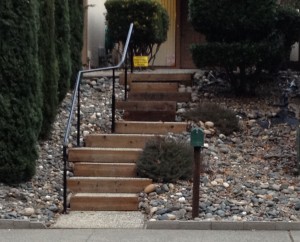Do You Mind Visitors’ Children? (Homeowner Hazards, Part 1)
Most people love children, and nobody likes to see a child hurt. Unfortunately, houses which aren’t child-proofed are filled with hazards many homeowners might not even notice.
Before children visit, homeowners should look for and correct the obvious dangers and also the lurking risks.
In the weeks to come, we’ll take a look at some of the hazards homeowners should beware when children are present. We’ll examine these dangers in pairs–one obvious, and one hidden hazard, in each installment.
THE OBVIOUS DANGER: STAIRCASES
Staircases–both indoor and outdoor–present a danger to children of all ages.
Very young children love to crawl around and explore the environment, particularly in unusual surroundings. “Crawlers” may accidentally fall down stairs, sustaining serious injuries, because they lack the dexterity to adjust their weight and use stairs safely. Babies and toddlers who live in houses without stairs, or who haven’t yet learned to use them, present the greatest falling risk, but even children familiar with stairs may tumble and fall if left unsupervised.
The solutions: close adult supervision and child-safe “baby gates” at both ends of every staircase.
A gate at the top of the stairs is not enough to keep a child from crawling up from the bottom and sustaining a serious–or even fatal–injury in a fall. Similarly, a gate at the bottom won’t keep a child safe when someone has carried him up the stairs. Secure baby gates at both ends of the staircase keep curious children off the stairs and help avoid serious falls.
However, baby gates are not enough. Supervise babies and toddlers closely, at all times, to avoid not only staircase-related harms but many other dangers within the home.
Older children like to run, and jump, in play. They frequently ignore handrails and other safety devices (and may leave baby gates ajar or unfastened, creating a danger not only to themselves but to other children in the home). Serious injuries may result from jumping on and off staircases, and sliding down banister railings.
The solutions: appropriate adult supervision, clear rules, and consequences for inappropriate play.
Although older children may not need the same, constant, supervision as infants and toddlers, children of all ages should have appropriate supervision at all times. Children should know (or be told) the household rules–and be aware that stairs and railings should always be used appropriately.
Never assume that a child will act responsibly. Even “responsible” children have lapses in judgment, and require adult supervision.
***
THE LURKING DANGER: SLIPPERY FLOORS
Staircases don’t present the only falling danger in the home. Slippery floors can also create a serious–and sometimes fatal–danger, particularly for children. Unlike adults, children often move through the house at a run and, left unsupervised, may engage in horseplay resulting in slips and falls.
Hardwood, tile, and loose (unsecured) rugs and hallway runners all present special, and serious, dangers to children. These hazards increase when floors are wet, after cleaning or during inclement weather.
The solutions: careful adult supervision, non-slip footwear, and attention to safety measures.
Whenever possible, ensure that children wear non-slip footwear indoors, particularly when surfaces are wet or especially slippery. Standard socks can add to slipping hazards, so consider slippers with non-slip bottoms as a foot-warming alternative.
Non-slip tacking and other measures help keep carpets and hallway runners secure and prevent unwanted accidents, and floor mats near exterior doors and bathrooms may help minimize water and slippery floors.
Most importantly, keep an eye on children to ensure that running and other dangerous behaviors are not allowed inside the house. Extra vigilance pays off in accident reduction.
Don’t rely on this post alone to “ensure” your home is safe. Inspect the property carefully before children (and other guests) arrive, and ensure that children always receive proper supervision.
Take necessary steps to correct the hazards you find, and be sure to look and think carefully about how a child might act in the home–a little extra prevention goes a long way toward keeping you, and your visitors, safe.















